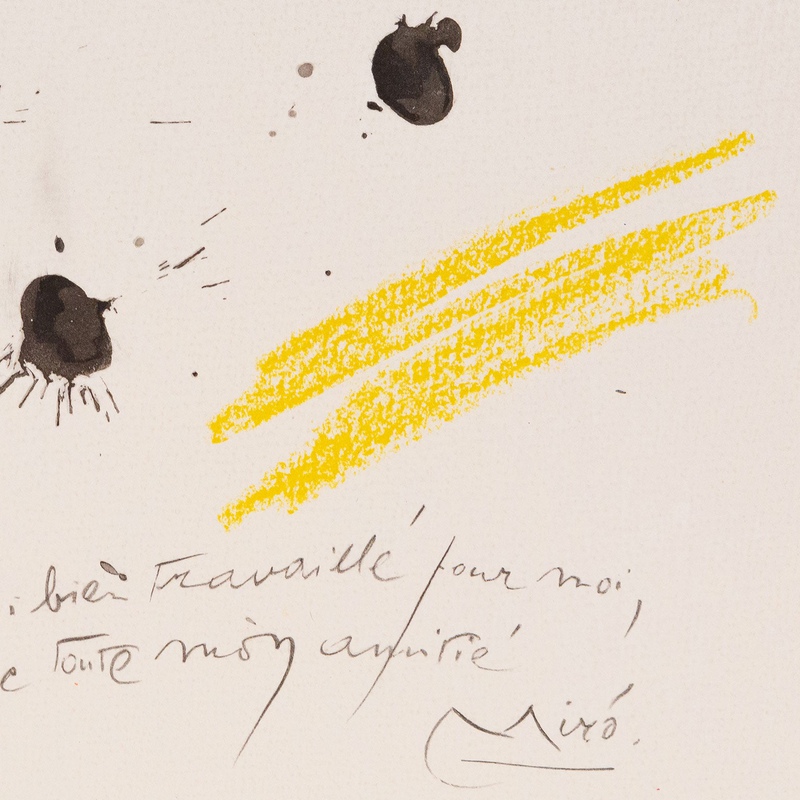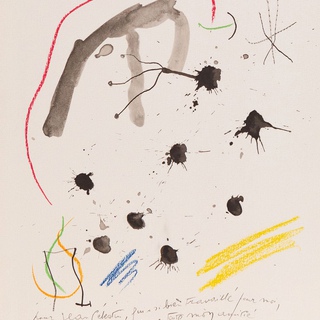About The Work
Joan Miró’s passionate rejection of traditional painting led him to reference and experiment with multiple styles including Cubism, Dutch Baroque, and Fauvism. His time in Paris in the 1920s and subsequent exposure to Surrealism helped develop his style into the eccentric and symbolic works he is best known for.
Miró developed a unique visual language by combining abstract elements, specific colors, and reoccurring motifs. His best-known period of work began in the early 1960s when he began receiving many public work commissions. His works are noted for their freshness, body language, and deep meanings. He is an important bridge between Surrealism and abstraction.
This print is a paradigm of his work and artistic expression. It is from the “Quelques Fleurs” portfolio. The prints in this portfolio were based on watercolors from his book “Je Travaille Comme un Jardiner” (“I Work Like a Gardener”) that were reproduced by Miró as an edition of prints. Each print in this portfolio was dedicated to one of his friends.
About Joan Miró
From The Magazine
- News & Events: 5 Reasons to Acquire These Classic Joan Miró Lithographs
- Art 101: Alexander Calder, More than a Sculptor, Made Paintings, Jewelry, and Stage Sets
- Art 101: How Masterpieces Get Sold: Behind 10 Contemporary Art Icons That Went Under the Hammer at Christie’s
- News & Events: MoMA’s First Decade: 10 Radical Exhibitions We Wish We Had Been Alive to See
- Art 101: More than Melting Clocks: 10 Surrealist Masterpieces You Need to Know
Lithograph
15.00 x 11.00 in
38.1 x 27.9 cm
This work is signed by the artist, and comes with a Certificate of Authenticity.
About The Work
Joan Miró’s passionate rejection of traditional painting led him to reference and experiment with multiple styles including Cubism, Dutch Baroque, and Fauvism. His time in Paris in the 1920s and subsequent exposure to Surrealism helped develop his style into the eccentric and symbolic works he is best known for.
Miró developed a unique visual language by combining abstract elements, specific colors, and reoccurring motifs. His best-known period of work began in the early 1960s when he began receiving many public work commissions. His works are noted for their freshness, body language, and deep meanings. He is an important bridge between Surrealism and abstraction.
This print is a paradigm of his work and artistic expression. It is from the “Quelques Fleurs” portfolio. The prints in this portfolio were based on watercolors from his book “Je Travaille Comme un Jardiner” (“I Work Like a Gardener”) that were reproduced by Miró as an edition of prints. Each print in this portfolio was dedicated to one of his friends.
About Joan Miró
From The Magazine
- News & Events: 5 Reasons to Acquire These Classic Joan Miró Lithographs
- Art 101: Alexander Calder, More than a Sculptor, Made Paintings, Jewelry, and Stage Sets
- Art 101: How Masterpieces Get Sold: Behind 10 Contemporary Art Icons That Went Under the Hammer at Christie’s
- News & Events: MoMA’s First Decade: 10 Radical Exhibitions We Wish We Had Been Alive to See
- Art 101: More than Melting Clocks: 10 Surrealist Masterpieces You Need to Know
Published by Société Internationale d'Art XXe Siècle, Paris
- Images of the original portfolio box and colophon page are available upon request
- Ships in 5 to 7 business days from Canada. Framed works ship in 9 to 11 business days from New York.
- This work is final sale and not eligible for return.
- Questions about this work?
- Interested in other works by this artist or other artists? We will source them for you.
- Want to pay in installments?
Contact an Artspace Advisor
advisor@artspace.com































